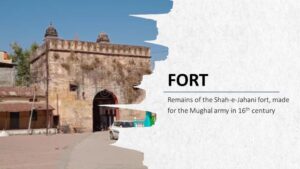Shajapur awaiting its next reincarnation?

Shajapur got its name after the Mughal Emperor Shah-e-Jahan (Kind of the World), as a memory of the young prince return from his invasion and crusade of the Deccan plateau, in early 1600s.
After a fierce war and the triumph of victory of the Mughals, while returning from Southern part of India, the young prince got mesmerised with the natural abundance and the unpretentious green splendor with environmental serenity and peace. It was a welcome break after a bloody combat of the war that the army had seen. So, he decided to take a halt in the place.
Later, he decided that the lush green region can be a camouflaged army based in the heart of India as a backup army offensive plan in case of any uprising toward the central India, and could serve the purpose of the Mughal military might. Therefore, subsequently when Shahjahan became the emperor, he recognised the importance of this place for keeping a control of the Southern part of the Kingdom. In 1640 Meer Bigo was appointed here as Kotwal. He with Shri Jagannath Rawal ji prepared four gates in four directions. Accordingly, this area was populated gradually and converted into a hidden army based amidst of the jungles in central India, serving the purpose of the backup army and intelligence network too. Then in respect of king Shahjahan it was named as “Shahjahanpur”. The name “Shahjahanpur” is now transformed to “Shajapur” due to local dialect in due course. In the British era, in year 1904, Shajapur was declared as a district, which is still maintained.
RIVER CHANDRALEKHA (CHILLAR)
It is said that Chadralekha River (which is now called Chillar) was flowing in North direction before but after establishment of huge fort and for its safety it was brought from East as a parikha of the fort. Chadralekha River happens to be a tributary of the mighty River Chambal in North West of Madhya Pradesh. But after the making of the famous Chillar Dam of Shajapur in the year 1972, the river has been marginalised into nothing more than a canal stream. Today it is majorly fed by the city sewage, storm water, run off water and the waste water. The span of the river within the city of Shajapur happens to be merely around two (2) kilometers and within this short distance a sewage of 11.25 MLD is contributed to the river making it look like a sewage drain. Unfortunately, there is no way out for the sewage due to the heavy usage of chemicals in our routine lives today, which is quite unsustainable, but for city planning we can’t change the behavioral patterns and lifestyles on an immediate basis.
The dam site itself is a big tourist attraction today. A splendid waterbody spread over 2000 + acres of Water with four different streams entering in the magnificent Waterbody from four sides, has turned it into a ornithologist’s haven, with birds chirping all over the place. A boat club by tourism department, was a natural outcome once the dam was functional. There’s a beautiful picnic site too, wherein one can find many local visitors with their families, at any point in the year.
WATER PLANNING IN SHAJAPUR
Shajapur is also a district headquarter and a city among the important cities of Western Madhya Pradesh. It is situated 60 Km from Dewas on National Highway No. 3 (Agra-Mumbai Road), 180 km from Bhopal – the State Capital in the south East and 95 km from Indore in the south West. Shajapur geographically lies at Latitudes 23°25” North and Longitude 75°25” East, while it is 435 meters above mean Sea Level. The city is situated on the banks of Chillar (Chadralekha, erstwhile) River.
A drinking water supply project @135 LPCD (liter per capita per day) has been executed under Urban Infrastructure Development Scheme for Small and Medium Towns (UIDSSMT), as a part of Jawahar Lal Nehru National Urban Renewal Mission. However, it was found that the Intake Well, constructed under this scheme, was not functioning during summer of 2020, as the water streams were observed to be receding. Although, a channel had been dug with an objective to feed water into the intake well during summer, but the experience was not satisfactory to the administration.
Therefore, SMC (Shajapur Municipal Council) decided to construct another Intake Well within the pool of water in the dam. Construction of the new intake well was completed in 2020 and the Raw Water Rising Main (RWRM) from new intake well to existing Water Treatment Plant was being laid and the remaining work of RWRM was expected to be completed by end of the year 2020. However, due to excessive prolonged rains in year 2019 followed by another good season of monsoon in year 2020, water in Chillar (Chadralekha) dam was ample and water through old intake well was being provided in the town. Shajapur Municipal Council (SMC) has also taken up a drive to ensure 100 per cent coverage with individual connections for drinking water supply. Approximately 75 per cent of the Households in project area were having tap water supply provided by the SMC. The Household Connection drive has slowed down due to COVID-19 pandemic; however, SMC is determined to connect all households with Municipal Water Supply.
The Urban planning department estimates the Shajapur population to grow from seventy-seven thousand people in the year 2019 to over a lakh of people by the year 2049 (77079 (Year 2019), 95724 (Year 2034), 119576 (Year 2049) as per the standard population growth trend. This would obviously impact the sewage generation as well, contributing towards the higher level of pollution and contamination in the river as well. As per the Shajapur Sewerage Project study (under MPUDP) the sewage production by the year 2049, is expected to be around 21.19 MLD, which means almost double of today’s production. Therefore in the developed India, which we are poised to see by 2047, we should probably be witnessing another reincarnation of the city of Shajapur, which will be even better developed in term of infrastructure and facilities, may be more monuments and landmarks to visit and may be a newer version of Chandralekha rive too.
Madhukar Swayambhu is known for his career in IT communication network industry for over two decades followed by his almost a decade long work in the environment ecology, Indic Knowledge System (IKS), and his invention of Cownomics® Technology, which is globally the most recognised, endorsed, certified, standardised and appreciated technology in Climate Tech space, which is completely based on Indian Vaidic Sciences. A TED speaker, he has been decorated with various national and international awards, including Water Hero, by the Union Ministry of Jal Shakti, and has been recognised
as globally No. 2 author by Smart Water Magazine, Spain.





